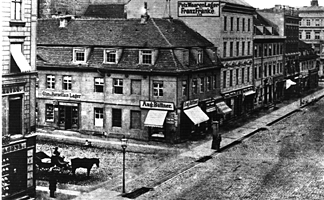FriedrichStraße
Friedrich I, The Soldier King needed housing for his growing population and for his growing population of soldiers. In 1735 he built a long community outside the city walls and offered a discount for families on the homes if they agreed to rent the upstairs to soldiers inexpensively. This housing with it's unique length accompanied courtyards for movement, and facilities necessary for family communities with less access to the city conveniences. The FriedrichStraße became a twofold model. First for Berlin, the courtyard style of apartment buildings is a trademark of Berlin living today, allowing extra light and communal services to apartment dwellers. Secondly, architects in 19th c. England, 20th c. Germany (such as Mies van Rhoe's influence on the Bauhaus) and American communities such as Radburn NJ, Levittown NY and PA, as well as many others have benefited from the influence of the earliest example of shared living communities.
This image below is taken at the corner of the FriedrichStraße and JagerStraße looking south toward TaubenStraße in 1865 (accross from a Polish Apothecary). A furier occupies the FranzFränke tall building, and a glass and porcelain shop is on JagerStraße. The two end buildings are original homes built by the Soldier King, the latter being 71 FriedrichStraße. Both corner buildings have a storefront. The end corner of FriedrichStraße and TaubenStraße is where the barracade of 1848 tipped over an applecart and two young craftsmen (boys) lost their lives to the batallion (pos. Frankfurt a/Oder) during the last hours of the revolution. It's this corner store that may house a jewelry business along with the young Friederici couple.

FriedrichStraße at JagerStraße, 1865.
When Bismark united Germany in 1871, the government initiated the development of this street which eventually became one of the most daring, elite, cafe, cabaret, and hotel neighborhood streets in the world. However it was almost completely bombed during WWII, and because it paralleled the wall on the East during the cold war, it was left desolate as "the end of the world", at least the communist world. While efforts began to build on this empty lot in the 1980's, it wouldn't be until the American architect Henry Cobb built Quartier 206, a posh mall which stands today on the entire block with the address 71 FriedrichStraße. Accross the street is a plaque commemorating the barricade of the 1848 Revolution.